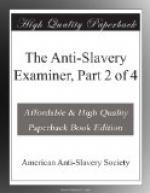A general return of exports from the island for fifty-three years, ending the 31st December last, and purporting to be extracted from the journals of the assembly, has been published, and as usual, the decrease in the crops of the respective years has been attributed to the resolutions passed by the British House of Commons in 1823, and the abolition of slavery in 1833. It is remarkable that in preparing this table, a manifest disposition is evinced to account for the falling off of the crops in certain years anterior, and subsequent to the passing of Mr. Canning’s memorable resolution, whilst opposite to the years 1834 and 1835, is written “seasons favorable.” In 1813, the sugar crop fell off 8,000 hhds. compared with the previous year, and we are told in reference to this circumstance, that there was a storm in October, 1812. This remark is evidently made to account for the decrease, and perhaps the storm at the close of the previous year was the cause of it. But it is astonishing, and the circumstance is worthy of notice, that whilst the sugar crop fell off nearly 8,000 hhds. the coffee crop increased nearly six millions of pounds. We should have supposed that the coffee trees would have suffered more from the effects of a storm, than the canes. However, the effect was as we have stated it, whatever might have been the cause. In 1814, the largest coffee crop was made. Again, in 1816, there was a decrease in the sugar crop compared with the year immediately preceding it of nearly 25,000 hhds. And here we have the storm of October, 1815, assigned as a reason. The coffee crop in this instance also fell off nearly ten millions of pounds. In 1822, the sugar crop was reduced 23,000 hhds., and the coffee crop increased three millions of pounds. The reason now assigned is an “extreme drought.” The celebrated resolutions relative to slavery now appear to begin to exercise their baneful influence on the seasons and the soil of our island. In the year in which they were passed, 1823, 94,900 hogsheads of sugar were made, and twenty millions of pounds of coffee gathered. 1824 came, and the crop, instead of being reduced, was increased from nearly 95,000 hogsheads to upwards of 99,000 hogsheads. The coffee crop was also greater by seven millions of pounds. In 1825, they fall off to 73,860 hogsheads and twenty-one millions. In 1826, the sugar crop rather exceeded that of 1824, but the coffee crop was seven millions less. In 1827, from causes not known to us, for none were assigned, there was a difference of 16,000 hhds. of sugar, and an increase of five millions of pounds of coffee. 1828, 29, and 30, were pretty nearly alike in sugar and coffee crops, and about equal to 1823. The crops of 1831 fell off from 93 to 88,000 hogsheads of sugar, and from 22 to 14 millions of pounds of coffee. No reason is assigned for this reduction. It was during the continuance of the driving system, and therefore no blame can attach to the managers.




